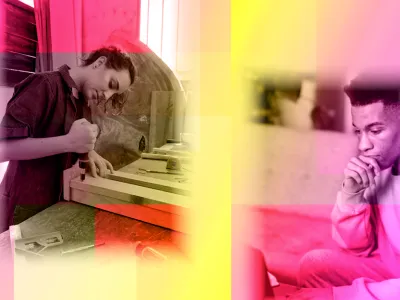
Job Dreams: Guide Dog Trainer
Ever fancied a job as a Guide Dog Trainer?
This interview is part of the Job Dreams series, where we speak to professionals from a wide range of careers. Last time we delved into what it’s like to earn a living as a Freelance Creative. Today, Dan (he/him), who’s employed as a Guide Dog Mobility Specialist, is giving you the low-down on what his job entails.

You’re working at a guide dog academy, what is it you do there?
I’m learning all about training guide dogs, the behaviours they’ll need to guide someone with sight loss, and I’m coaching individuals with visual impairment on how to live and work with a guide dog.
Tell us a little bit about how you got to where you are today?
I’ve always loved animals and nature, and so I studied Zoology at university, and then went on to do a postgraduate degree in Primate Behaviour, Biology and Conservation. My first job was leading student expeditions in remote wildlife hotspots like the Amazon rainforest! I then moved on to working for Battersea Dogs and Cats Home as a Community Engagement Officer, taking dogs into different learning environments like schools and prisons, and running workshops around behaviour, handling and welfare. I also worked as a Fundraiser and Diversity & Inclusion Lead. The people skills, the coaching and training skills, the hands-on animal experiences, and my love for learning, all supported me when I joined the Guide Dogs Academy programme.
What does your day-to-day look like?
As cliché as it sounds, the days really do vary in this job. The role of a Guide Dog Mobility Specialist covers a wide remit. One day I can be training our fosterers who look after the guide dogs in training; the next, I might be using positive reinforcement training to encourage a dog to learn how to guide a service user (which is what we call our customers with visual impairment); the next, I could be assessing a new service user on their suitability for a guide dog.
Out of interest, how long does it usually take to train a guide dog?
A guide dog typically takes six months to become “class ready” — that’s when the dog is ready to begin training with their matched service user. We then spend around five to eight weeks coaching the service user in working with their new guide dog.
What do you love most about your job?
It’s the individuality of it all. Each dog has different temperaments, different unique qualities, and different training needs. The same is true of our service users — I’ve been truly inspired by their stories. And what’s not to like about working with dogs?!
What’s the most challenging part of your job?
Whilst I’ve not yet experienced this personally, I suspect the grieving element will be the most challenging. By grieving, I mean loss in whatever form it takes — be it supporting a first time service user who has recently had their sight loss occur, or having a guide dog in training not quite make the grade (although there are alternative careers for dogs who get withdrawn from the programme!).

What did you see yourself doing when you were a kid?
All I knew is that I wanted to work with animals, and I didn’t want to be working in an office or always behind a desk.
Where do you see your career going next?
Honestly, I think this is the career for me. It’s early days and you never know what the future holds, but I’ve finally found a role that combines my love of working with people in a coaching role whilst also working hands-on with animals. That’s a win-win for me!





